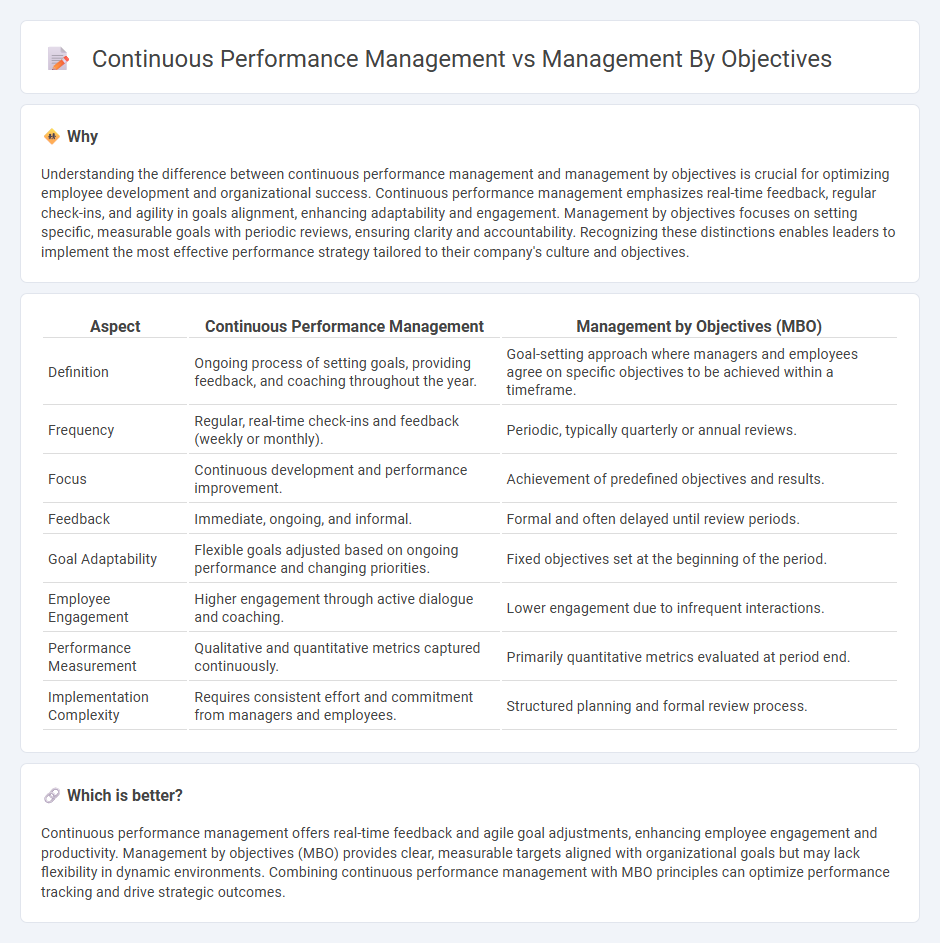
Continuous performance management fosters real-time feedback and agile goal adjustments to enhance employee development and productivity, contrasting with management by objectives (MBO), which relies on predetermined goals and periodic evaluations. This dynamic approach leverages frequent conversations and data-driven insights to align individual performance with evolving organizational priorities. Discover how integrating continuous performance management can revolutionize your leadership strategy.
Why it is important
Understanding the difference between continuous performance management and management by objectives is crucial for optimizing employee development and organizational success. Continuous performance management emphasizes real-time feedback, regular check-ins, and agility in goals alignment, enhancing adaptability and engagement. Management by objectives focuses on setting specific, measurable goals with periodic reviews, ensuring clarity and accountability. Recognizing these distinctions enables leaders to implement the most effective performance strategy tailored to their company's culture and objectives.
Comparison Table
| Aspect | Continuous Performance Management | Management by Objectives (MBO) |
|---|---|---|
| Definition | Ongoing process of setting goals, providing feedback, and coaching throughout the year. | Goal-setting approach where managers and employees agree on specific objectives to be achieved within a timeframe. |
| Frequency | Regular, real-time check-ins and feedback (weekly or monthly). | Periodic, typically quarterly or annual reviews. |
| Focus | Continuous development and performance improvement. | Achievement of predefined objectives and results. |
| Feedback | Immediate, ongoing, and informal. | Formal and often delayed until review periods. |
| Goal Adaptability | Flexible goals adjusted based on ongoing performance and changing priorities. | Fixed objectives set at the beginning of the period. |
| Employee Engagement | Higher engagement through active dialogue and coaching. | Lower engagement due to infrequent interactions. |
| Performance Measurement | Qualitative and quantitative metrics captured continuously. | Primarily quantitative metrics evaluated at period end. |
| Implementation Complexity | Requires consistent effort and commitment from managers and employees. | Structured planning and formal review process. |
Which is better?
Continuous performance management offers real-time feedback and agile goal adjustments, enhancing employee engagement and productivity. Management by objectives (MBO) provides clear, measurable targets aligned with organizational goals but may lack flexibility in dynamic environments. Combining continuous performance management with MBO principles can optimize performance tracking and drive strategic outcomes.
Connection
Continuous performance management enhances management by objectives by providing real-time feedback and regular progress reviews, ensuring alignment with set goals. This dynamic approach fosters accountability and agility, enabling managers to adjust objectives based on ongoing performance data. Integrating continuous performance management with management by objectives drives higher employee engagement and goal attainment efficiency.
Key Terms
Goal Setting
Management by Objectives (MBO) centers on setting specific, measurable goals aligned with organizational strategy, typically reviewed periodically to evaluate performance outcomes. Continuous Performance Management emphasizes ongoing feedback and real-time adjustments to goals, fostering agility and continuous employee development. Explore how integrating these approaches can optimize goal setting and enhance employee engagement.
Feedback
Management by Objectives (MBO) emphasizes setting specific, measurable goals and evaluating performance primarily through periodic reviews, often resulting in delayed feedback. Continuous Performance Management (CPM) prioritizes real-time, ongoing feedback to foster employee development and agility, enhancing goal alignment and responsiveness. Explore further to understand how feedback mechanisms impact performance outcomes in each approach.
Evaluation Frequency
Management by Objectives (MBO) typically involves setting specific, measurable goals evaluated quarterly or annually, which can delay feedback and adjustments. Continuous Performance Management (CPM) emphasizes ongoing, real-time evaluations through frequent check-ins, enabling agile responses to performance issues and development needs. Explore detailed comparisons to enhance your organization's performance review strategy.
Source and External Links
Management by Objectives (MBO): The Complete Guide - Provides a comprehensive overview of Management by Objectives, including its definition, examples, and implementation in organizations.
Management by Objectives (MBO) - Describes MBO as a strategic approach to enhance organizational performance by setting and achieving company goals through employee objectives.
Management by Objectives - Explains MBO as a management process that involves defining specific objectives within an organization and aligning individual goals with organizational goals.
 dowidth.com
dowidth.com